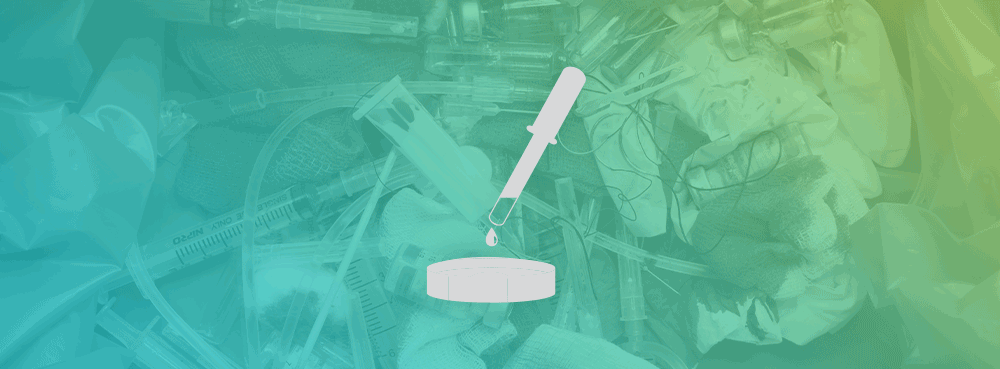10 Most Common Types of Infectious Waste

Identifying the types of waste streams generated in healthcare facilities is essential for proper and compliant waste management. Several streams are readily identifiable, such as sharps, pathological and anatomical waste, blood or body fluid waste, and chemotherapy waste.
If you’re a health provider, it pays to know the 10 most common types of infectious waste.
If you aren’t familiar with the most common types of infectious waste, you run the risk of non-compliance with disposal regulations. This could result in massive fines and penalties.
When it comes to medical waste, it’s crucial to avoid commingling infectious and non-infectious materials. Understanding the difference between these types of waste is the only way to avoid this.
TOPICS WE WILL COVER:
2 / 10 Types of Infection Waste
3 / State Guidelines For Disposing of Infectious Waste
4 / Protecting Clinical and Downstream Service Staff
5 / Be Equipped to Manage Your Infectious Waste Effectively
What is Infectious Waste?
Infectious waste is defined as an organism or waste product, typically found in healthcare or health related industries, that is capable of causing infection.
In addition to federal guidelines regarding the handling and treatment of infectious waste, every state in the country has its own recommendations.
Infectious waste disposal processes must be followed to protect employees, the general public, and the environment.
10 Types of Infectious Waste
Some of the most common types of infectious waste that healthcare workers or individuals can be exposed to are:
Blood
Blood products include plasma, serum, and additional blood components, as well as those found in containers or perhaps saturated solid waste.
Pathological Waste
Pathological waste is another type of infectious waste. Pathological waste is defined as tissues or body parts removed from a human or animal either accidentally, during a surgical procedure, or during an autopsy and intended for disposal.
Sharps
Sharps include needles, scalpels, blades, or any “sharp” item that is used to inoculate or provide drugs. This also includes sharps used to draw blood from an animal or human.
Possible medical waste generators dealing with this type of infectious waste include mortuaries, blood banks, hospitals, laboratories, and research facilities.
Sharps can also include pipettes, lancets, or other discarded glass or hard plastic vials that contain an infectious agent. Sharp objects that are capable of penetrating or cutting the skin can also include razor blades, suture needles, trocars, butterflies, broken capillary tubes, culture slides and dishes, and empty ampoules.
Laboratory Waste
Laboratory waste includes cultures, stocks, or materials used in research or disease analysis that can infect humans if exposed; for example, wastes that come from the production of biological agents or discarded live or attenuated vaccines that may be infectious.
Animal Waste
Animal waste is a common type of infectious waste. Animal waste may be produced due to scientific or medical research. As with humans, any blood, body part, or carcass of an animal that has been exposed to infectious agents may also potentially cause harm to humans.
Regulated Human Body Fluids
Regulated human body fluids include amniotic fluid, cerebrospinal fluid, pleural fluid, pericardial fluid, and so forth.
This type of infectious waste is also defined as anything that is stored in a container or a substance that may drip from solid waste items, such as bedding or bandages that are soaked with body fluids.
State Guidelines for Disposing of Infectious Waste
States around the country may have their own guidelines for the management of infectious waste. For example, Minnesota’s Pollution Control Agency publishes guidelines for infectious waste management for generators. They, like others, will specifically state how infectious waste is regulated and what types of waste are considered infectious in that state. For example, Minnesota states that regulated human body fluid is something that is “not normally released from the body.”
Teeth
In some states, teeth are classified as a type of infectious waste. The CDC states that extracted teeth are subject to the guidelines of the Occupational Safety and Health Administration’s Blood-borne Pathogen Standard. This deems extracted teeth to possibly contain infectious materials.
Therefore, they should be disposed of in adequate and appropriate medical waste containers (with the exception of teeth containing amalgam, which are not to be incinerated). Refer to local and state regulations for disposal of teeth containing amalgam.
Solid Waste
Solid waste may also be deemed a type of infectious waste. This includes items such as IV tubing equipment, suction canisters, surgical gloves, personal protective equipment (PPE), and wound dressings.
All of these items may contain blood or bodily fluids that are “pourable, drinkable, squeezable, or flakable”, according to OSHA.
Chemotherapy Waste
Chemotherapy waste also has the potential to be infectious, depending on the status of the patient. It also depends on the delivery of chemotherapy drugs that have the potential to transfer blood or body fluids from one person to another.
Common items that may be deemed infectious include tubing, sheets, pads, vials, gloves, containers, and IV bags.
Any Material Contaminated With a Communicable Disease
Workers employed in a variety of healthcare facilities, including hospitals, nursing homes, outpatient clinics, and even veterinary clinics and tattoo parlors, should always use protection to avoid exposure to communicable diseases.
In some nursing homes, influenza, urinary tract infections, and scabies may spread from one resident to another. They can also spread to carers if proper identification, treatment, and PPE aren’t utilized.
Protecting Clinical and Downstream Service Staff
One of the driving factors behind a stringent infectious waste management plan is the protection of those who come into contact with infectious waste. Measures to protect the workers who generate and handle this medical waste include:
- Fit-for-purpose bins for the collection of infectious waste
- Following OSHA guidelines for discarding of regulated medical-waste items
- Employing waste handling practices that minimize the “touches” of infectious waste and its outer packaging
- Tamper-proof containment before collection, ensuring waste is sealed in leakproof packaging
- Waste consolidation and readyness for storage and transport that minimizes the risk of spillage and cross-contamination
These measures are designed to protect workers who come into contact with infectious or potentially infectious waste, from point of generation to disposal.

Be Equipped to Manage your Infectious Waste Effectively
Healthcare facilities should take the proper measures to ensure effective waste segregation and adequate biohazardous waste disposal. Proper waste stream identification and waste segregation are essential to protecting employees, the public, and the environment from potentially infectious waste.
Refer to the CDC’s guidelines for Environmental Infection Control in Healthcare Facilities. These will help you understand how to achieve best practices as well as the regulations that govern medical waste. At Daniels Health, our products, education, and resources provide valuable, sustainable, cost-effective, and compliant protection for healthcare facilities.
We’re recognized as the national leader in clinically designed waste services. Our solutions minimize infection risk and protect healthcare workers while handling infectious waste. For more information on the different types of infectious waste and how we can help your organization manage them, call us today.
Let's Talk!
Your time is valuable, and we don’t want to play hard to get. You can either phone us directly on the details listed on our contact page, or feel free to fill out this short form and one of our team members will get back to you as quickly as possible.
